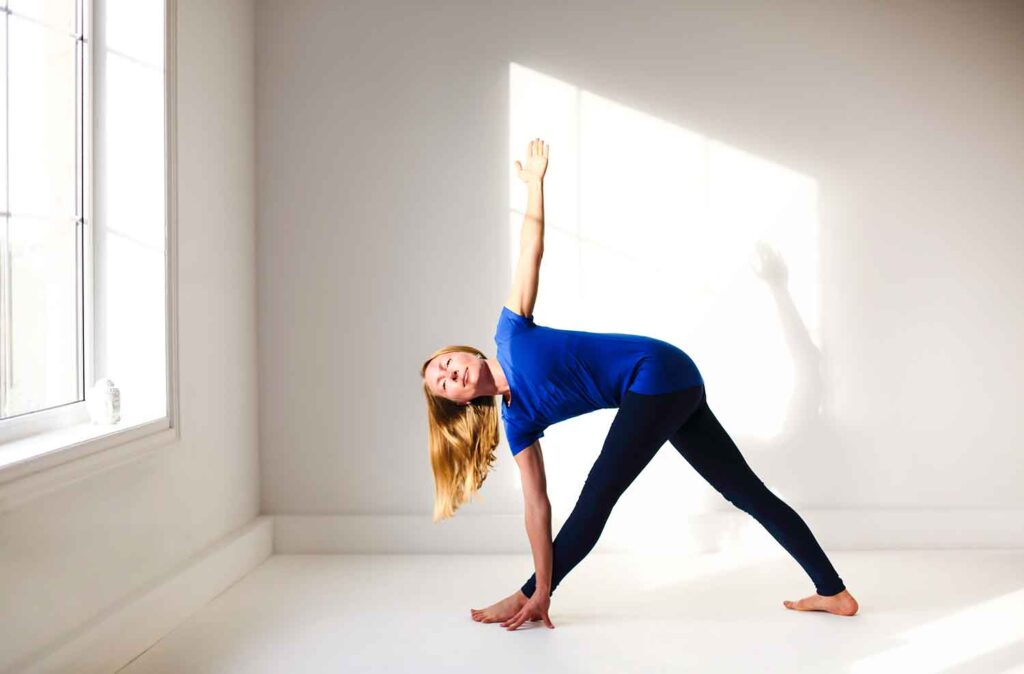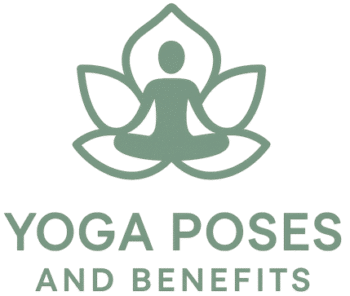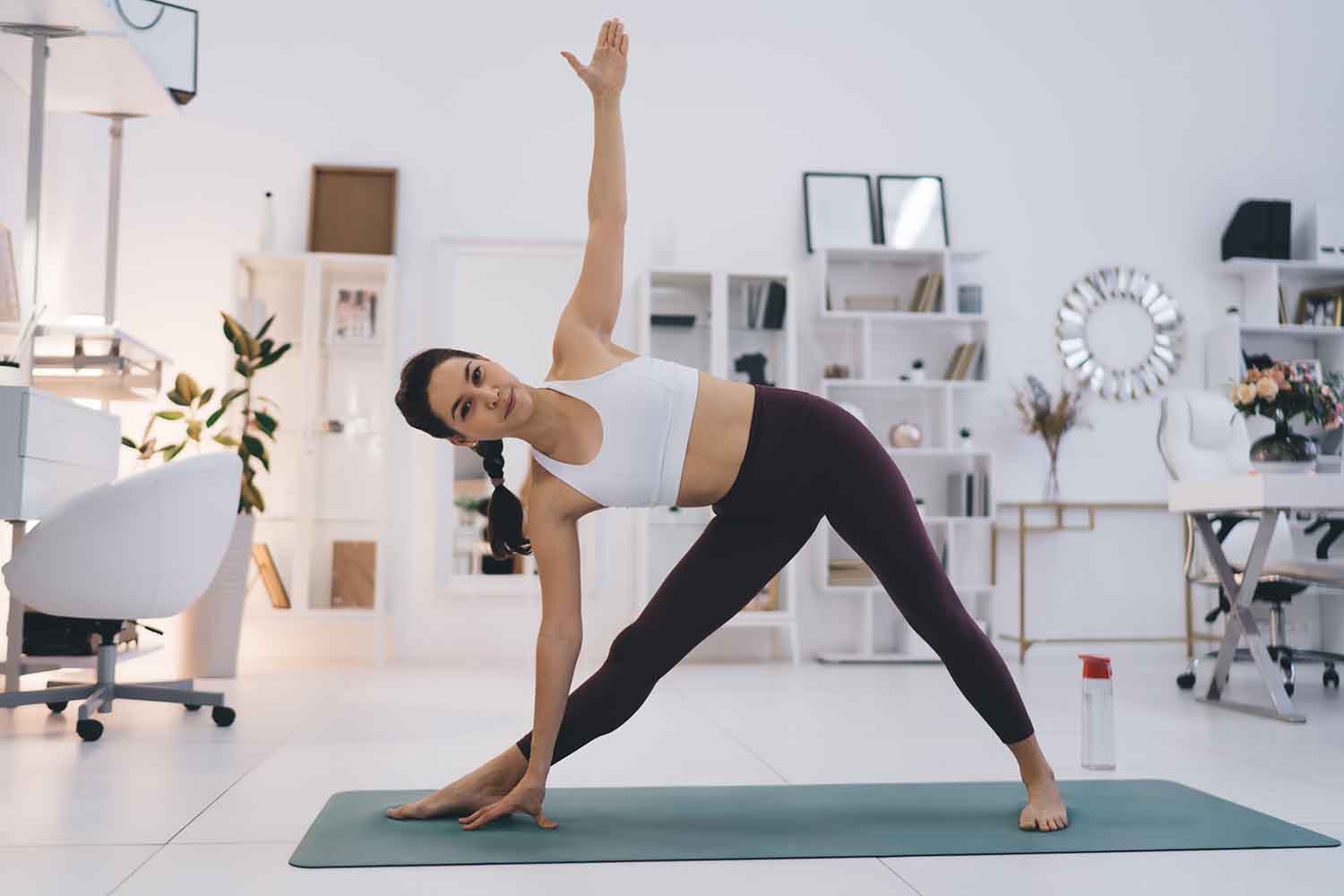Revolved Triangle Pose in yoga (Parivrtta Trikonasana) is a powerful standing twist that stretches the hamstrings, strengthens the legs, and detoxifies the body through spinal rotation. This pose challenges both balance and flexibility while stimulating internal organs and improving digestion.
Other Names for Revolved Triangle Pose
- Parivrtta Trikonasana
- Twisting Triangle Pose
- Revolved Three Angle Pose
How to Do Revolved Triangle Pose in Yoga
To perform Revolved Triangle Pose, follow these detailed steps:
- Begin in Mountain Pose (Tadasana), then step your feet about 3 to 4 feet apart. Turn your right foot out 90 degrees and slightly angle your left foot inward.
- Square your hips forward, drawing your left hip slightly forward and your right hip back to ensure alignment.
- Inhale, extending your arms out to the sides at shoulder height. As you exhale, hinge forward from the hips, keeping your spine long.
- Place your left hand on the outside of your right foot, ankle, or shin. For additional support, you may rest your hand on a block. Reach your right arm toward the ceiling, creating a twisting motion through your torso.
- Focus on deepening the twist with each exhale while keeping your hips stable and aligned. Gaze toward your raised hand or keep your neck neutral by looking straight ahead.
- Hold the pose for several breaths, lengthening through your spine and rotating your torso. To exit, inhale as you rise up and repeat the pose on the other side.
Variations of Revolved Triangle Pose
Consider these variations to deepen or modify your practice:
- Bound Revolved Triangle: For a more intense stretch, bind your arms behind your back by bringing the lower arm under the front thigh and reaching the upper arm behind your back to clasp hands.
- Revolved Triangle with a Chair: Use a chair to rest your bottom hand if you have limited flexibility or balance, allowing you to focus on alignment and rotation.
- Half Revolved Triangle: Bend your front knee slightly to ease into the pose and reduce pressure on the hamstrings.
Modifications for Revolved Triangle Pose
Revolved Triangle can be challenging, but modifications make it accessible to practitioners of all levels:
- Use a Block: Place a block under your lower hand to bring the ground closer and maintain a straight spine if your flexibility is limited.
- Shorten the Stance: Narrow your stance by bringing your feet closer together. This reduces the intensity of the hamstring stretch and helps maintain balance.
- Bend the Front Knee: For those with tight hamstrings or lower back discomfort, slightly bending the front knee can alleviate strain.

Contraindications for Revolved Triangle Pose
Certain conditions require caution or modification when practicing Revolved Triangle Pose:
- Lower Back Injuries: Twisting can exacerbate lower back pain, so those with back issues should practice with care, using props or avoiding deep twists.
- Pregnancy: As the abdomen is compressed during the twist, pregnant practitioners should avoid this pose or practice a more open version without deep spinal rotation.
- High or Low Blood Pressure: Twisting and forward folding can affect blood pressure, so those with these conditions should proceed cautiously or use modifications.
Tips to Improve Revolved Triangle Pose in Your Practice
Revolved Triangle Pose requires focus and alignment. Here are some tips to help:
- Engage the Core: Activate your core muscles to support the twist and protect your lower back from strain.
- Lengthen Before You Twist: Focus on elongating your spine before rotating. This will help maintain the integrity of the twist and avoid compressing the spine.
- Keep Your Hips Square: Draw your front hip back and your back hip forward to ensure proper alignment and avoid over-twisting the torso.
- Ground the Back Foot: Press firmly into your back foot, especially through the outer edge, to stabilize your legs and balance.
- Breathe into the Twist: Use your breath to deepen the twist with each exhale, while maintaining length in your spine.
What Muscles Does Revolved Triangle Pose Work?
Revolved Triangle (Parivrtta Trikonasana) engages and stretches multiple muscle groups:
- Hamstrings: The front leg’s hamstring stretches deeply as you hinge forward.
- Hip Flexors: The back leg’s hip flexors and psoas are lengthened as you maintain alignment in the pose.
- Core Muscles: Twisting the torso engages the obliques and helps build core strength and stability.
- Spinal Muscles: The erector spinae and other muscles along the spine are engaged as you twist and extend, improving spinal flexibility.
- Legs and Feet: Both legs work to stabilize the pose, engaging the quadriceps, glutes, and calves.
- Shoulders and Upper Back: The arms and shoulders stretch and open as you extend your arms in opposite directions.
Mental and Emotional Benefits of Revolved Triangle Pose in Yoga
Revolved Triangle offers several mental and emotional benefits:
- Enhances Mental Focus: Balancing while twisting requires concentration, which sharpens mental clarity and focus.
- Stimulates Energy Flow: The spinal twist in this pose helps release energy blockages, promoting a sense of renewal and vitality.
- Detoxifies the Body: The twisting motion stimulates internal organs, aiding in detoxification and digestion.
- Releases Emotional Tension: Twisting poses like Revolved Triangle can help release stored tension in the body, promoting emotional balance.
Is Revolved Triangle Pose Suitable for Beginners?
While Revolved Triangle is a challenging pose, beginners can safely practice it with the right approach:
- Use a Block: Place a block under your bottom hand to bring the ground closer and maintain a long spine without overreaching.
- Shorten the Stance: Keeping the feet closer together reduces the intensity of the hamstring stretch and improves balance.
- Focus on Alignment: Beginners should prioritize proper alignment over the depth of the twist. It’s more important to maintain a stable foundation than to twist too deeply.
Is Revolved Triangle Pose Suitable for Advanced Practitioners?
Advanced practitioners can take Revolved Triangle Pose deeper by refining their alignment and exploring more challenging variations:
- Deepen the Twist: Focus on bringing the opposite ribs closer to the inner thigh while maintaining length in the spine to enhance the twist.
- Bind the Arms: For a deeper shoulder and chest stretch, try binding your arms behind your back, clasping your hands, or using a strap.
- Practice Without a Block: For a more advanced variation, place your bottom hand on the floor or on the outer edge of the front foot.
How Does Revolved Triangle Pose Contribute to a Yoga Sequence or Flow?
Revolved Triangle plays a valuable role in a yoga sequence:
- Counterposes Backbends: Following a deep backbend, Revolved Triangle provides a beneficial counterpose that stretches and lengthens the spine.
- Enhances Twisting Sequences: This pose fits well into sequences that focus on spinal twists, detoxification, or core strengthening.
- Transitions Between Standing Poses: It serves as a bridge between other standing poses like Triangle Pose (Trikonasana) and Extended Side Angle Pose (Utthita Parsvakonasana), creating fluid transitions in a flow.
How Can I Deepen My Practice in Revolved Triangle Pose?
To deepen your practice in Revolved Triangle Pose, focus on the following techniques:
- Lengthen Your Spine: Before twisting, create as much length in your spine as possible. This creates space for a deeper and safer twist.
- Engage Your Core: Activate your core muscles throughout the pose to support the twist and protect your lower back.
- Press into Your Back Foot: Grounding through your back foot stabilizes your legs and allows you to twist more effectively.
- Use the Breath to Deepen the Twist: On each exhale, rotate slightly deeper into the twist while maintaining a steady and even breath.
Common Mistakes in Teaching Revolved Triangle Pose
Avoid these common mistakes to improve the practice of Revolved Triangle:
- Over-Twisting the Lower Back: Encourage students to twist from the upper spine rather than forcing the twist from the lower back, which can lead to strain or injury.
- Misaligned Hips: Many students let their hips rotate out of alignment. Emphasize squaring the hips and keeping them stable throughout the pose.
- Collapsing the Spine: Students often round their back to reach the floor. Remind them to use a block if necessary and focus on keeping the spine long rather than reaching for the ground.
- Forcing the Twist: Encourage students to twist only as far as is comfortable, using the breath to deepen the pose gradually without forcing the movement.
By addressing these mistakes, instructors can help students achieve a safer and more effective practice in Revolved Triangle Pose.

